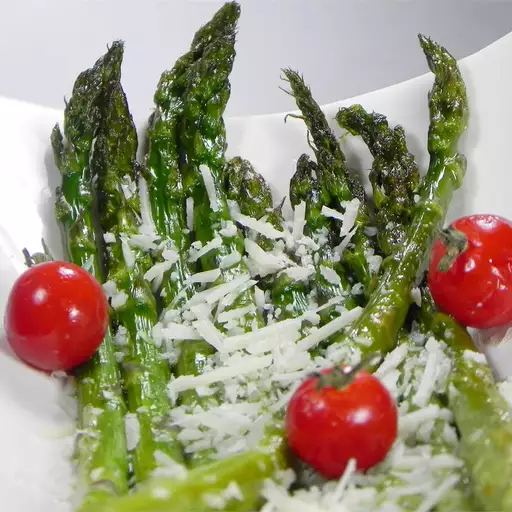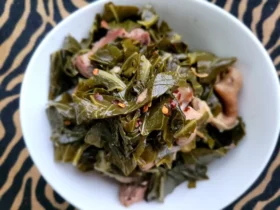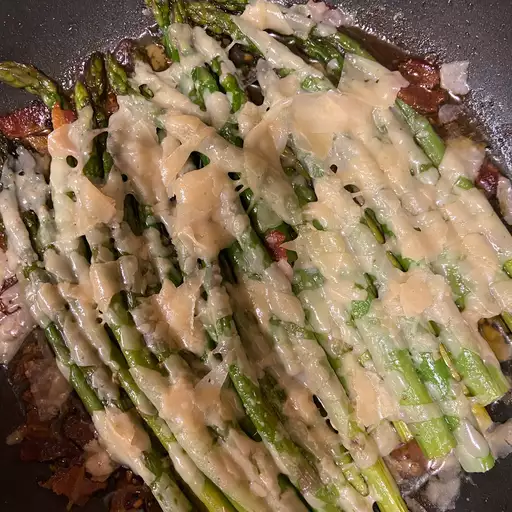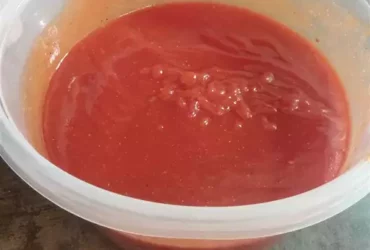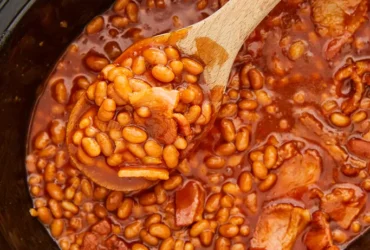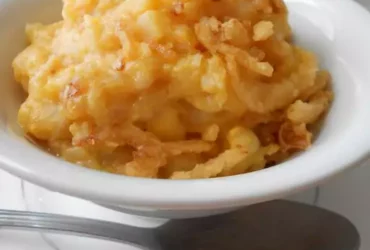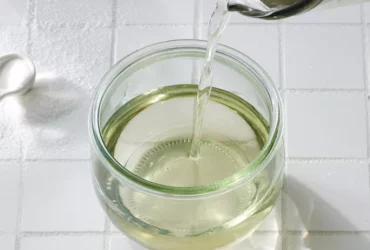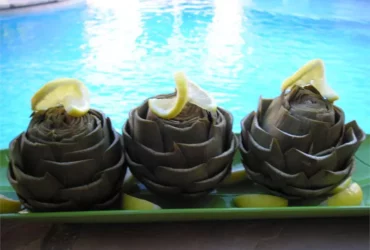Ingredients
For the asparagus
The ingredients for the asparagus are a crucial part of this Asparagus Parmesan Recipe. To begin with, you will need 1 pound of fresh asparagus, preferably with thick stalks that can hold their own when cooked. This amount should serve four people, depending on serving sizes and individual appetites.
Next, prepare the necessary seasonings to enhance the flavor of your asparagus without overpowering it. You will need 2 tablespoons of olive oil, which is essential for roasting the asparagus in the oven. Additionally, mix 1/4 teaspoon of salt and 1/4 teaspoon of black pepper to season the asparagus during cooking.
The crowning glory of this recipe is undoubtedly the Parmesan cheese. To make it more substantial and flavorful, you will need 1/4 cup of grated Parmesan cheese, preferably freshly grated to maximize its flavor. Be sure not to use the pre-shredded or pre-grated versions from stores, as they often contain additives that can affect the final taste.
Finally, garnish your Asparagus Parmesan Recipe with some fresh parsley leaves for added freshness and color. You can also choose to use other herbs like basil or chives if you prefer their flavor. Simply chop 2-3 tablespoons of fresh parsley leaves into fine pieces and sprinkle them over the asparagus before serving.
The combination of these ingredients will undoubtedly elevate your Asparagus Parmesan Recipe to new heights, making it a delightful side dish for any meal or occasion.
1 pound fresh asparagus, trimmed
In order to make a delicious Asparagus Parmesan dish, it’s essential to start with fresh and high-quality ingredients. Here are some details about 1 pound fresh asparagus, trimmed:
Description
The 1-pound package of fresh asparagus contains approximately 12-15 spears, depending on their thickness and size.
Here’s a closer look at what to expect from this ingredient:
- Color: The asparagus should have a vibrant green color with no signs of wilting or yellowing.
- Texture: The spears should be firm and tender, with a slight crunch when bitten into.
- Size: The thickness of the spears will vary, but they should generally range from 1/4 to 3/4 inch in diameter.
Care and Handling
To ensure optimal freshness and flavor, handle the asparagus gently and store it in a dry, cool place. You can also trim the ends of the spears before using them to help remove any tough or fibrous parts.
For the parmesan sauce
The key to creating an authentic Italian-style Parma sauce lies in the quality and combination of its ingredients. For a rich, creamy, and savory parmesan sauce that perfectly complements the delicate flavor of asparagus, you’ll need:
Butter or Olive Oil: You can choose either butter or olive oil for sautéing the onions and garlic, but keep in mind that butter will add more richness to your sauce. Start with a higher quality, salted European-style butter or extra virgin olive oil for a lighter option.
Onions and Garlic: Sauté a combination of finely chopped onion and minced garlic until they’re translucent and fragrant. This will add depth and sweetness to your parmesan sauce. For two people, use about 1 small onion (chopped) and 2 cloves of garlic (minced).
White Wine or Chicken Broth: A splash of dry white wine, like Pinot Grigio, Chardonnay, or even champagne can add a nice depth to the sauce. However, if you’re not a fan of wine or prefer not to cook with it, a homemade chicken broth is an excellent substitute for moisture and flavor.
Heavy Cream: A generous amount of heavy cream is essential for achieving a luscious texture in your parmesan sauce. It provides the necessary fat content to balance out the acidity from the tomatoes (if using canned) or wine.
Parmesan Cheese: The star ingredient! Good-quality Parmigiano-Reggiano cheese will give you an authentic Italian flavor and help thicken the sauce beautifully. You’ll need about 1/2 cup (120g) of grated, aged Parmesan. Freshly grate it before adding to ensure optimal flavor.
Salt and Black Pepper: Season your sauce liberally with salt to balance the flavors. Add a pinch of freshly ground black pepper for added depth.
Parmesan Sauce Tips:
- To enhance the flavors, you can add some chopped fresh parsley or basil leaves towards the end of cooking.
- If you’re using canned tomatoes, make sure they are well-drained and rinsed under cold water to avoid excess sodium.
2 tablespoons olive oil
The Asparagus Parmesan recipe is a delicious and elegant side dish that highlights the natural flavors of asparagus, rich parmesan cheese, and a hint of nutty olive oil.
When it comes to cooking this dish, olive oil plays a crucial role. Specifically, we will be using 2 tablespoons of high-quality olive oil that provides a smooth texture and a distinct flavor profile.
The olive oil is chosen for its health benefits and its ability to enhance the flavors of the other ingredients in the recipe. It is rich in monounsaturated fats, which have been shown to lower cholesterol levels and reduce inflammation.
Olive oil also has a high smoke point, making it ideal for sautéing the asparagus without breaking down its delicate flavor compounds or creating unhealthy compounds when heated to high temperatures.
The 2 tablespoons of olive oil are divided equally among three parts: one part is used to coat the asparagus spears before cooking, another part is added to the pan during cooking, and a final portion is drizzled on top of the dish after serving for added flavor.
This thoughtful approach to using olive oil ensures that every bite of the Asparagus Parmesan recipe is infused with its unique taste and aroma, elevating this simple yet impressive side dish to new heights.
4 cloves garlic, minced
- The key to a great Asparagus Parmesan recipe lies in its ingredients, and one essential component is the use of four cloves of garlic, minced.
- To understand the significance of garlic in this dish, let’s break down its role:
- Garlic adds a pungent flavor that complements the sweetness of asparagus without overpowering it.
- When used in moderation, garlic helps to bring out the natural flavors of other ingredients in the recipe.
- Now, let’s dive deeper into the process of working with garlic:
- To mince four cloves of garlic, you’ll want to start by peeling each clove and placing it on a cutting board. You can use a chef’s knife or a garlic press to achieve the desired texture.
- The goal is to break down the garlic into small, uniform pieces that will distribute evenly throughout the dish. A good rule of thumb is to aim for about 1-2 mm in diameter for each piece of minced garlic.
- Once you have your garlic minced, be sure to sauté it in a little olive oil until fragrant, but not browned. This step helps to mellow out the flavor and prevents any bitterness from developing.
- As you continue to prepare your Asparagus Parmesan, keep in mind that the four cloves of garlic will be the foundation upon which the rest of the flavors are built. By mastering the art of mincing and sautéing garlic, you’ll be well on your way to creating a truly exceptional dish.
- In terms of quantity, the four cloves of garlic in this recipe serve as a good starting point for most home cooks. However, feel free to adjust to taste, as some people may prefer a stronger or milder garlic flavor in their Asparagus Parmesan.
1 cup grated Parmesan cheese
Parmesan cheese is an essential ingredient in the Asparagus Parmesan recipe, and it plays a crucial role in adding flavor and texture to this popular dish.
The first thing to note about Parmesan cheese is its high quality and distinct characteristics. It is typically made from cow’s milk that has been aged for a minimum of two years, which gives it a sharp, nutty flavor and a crumbly, granular texture.
This particular ingredient requires attention when it comes to the amount needed for the recipe. For this Asparagus Parmesan Recipe, you will need 1 cup of grated Parmesan cheese, which should be enough to coat the asparagus spears evenly.
When selecting Parmesan cheese for your recipe, look for a high-quality variety that is finely grated and has not been pre-mixed with any other ingredients. This will ensure that you get the best flavor and texture possible from this essential component of the dish.
Parmesan cheese adds a rich, savory flavor to the asparagus spears, balancing out their natural sweetness. It also provides a satisfying crunch when sprinkled on top of the pasta or used as a topping for various Italian-inspired dishes.
The type and quality of Parmesan cheese can vary depending on factors such as region, production methods, and age. However, it’s worth noting that authentic Parmesan cheese made from cow’s milk is always aged in a natural environment, resulting in its distinctive flavor and texture.
Some people may be interested to know that Parmesan cheese is often labeled with different terms such as “Parmigiano-Reggiano” or simply “Parmesan.” These labels refer to the origin of the cheese, which can impact its quality, taste, and texture. However, for this recipe, a basic grated Parmesan cheese should suffice.
It’s worth mentioning that in Italian cooking, Parmesan cheese is often served as a topping for various dishes, such as pasta, pizza, and salads. In the case of this Asparagus Parmesan Recipe, it serves as an essential component to add flavor and texture to the dish.
In summary, when working with 1 cup grated Parmesan cheese in your Asparagus Parmesan Recipe, focus on selecting high-quality ingredients that provide a distinct flavor and texture. Be sure to grate the cheese finely to ensure even coating of the asparagus spears, and adjust the amount according to personal preference for a rich, satisfying taste experience.
2 tablespoons allpurpose flour
All-purpose flour is a fundamental ingredient in baking and cooking, but its role may not be immediately apparent when it comes to the Asparagus Parmesan recipe.
In this recipe, 2 tablespoons of all-purpose flour serve as a coating for the breaded portion of the dish. All-purpose flour’s high starch content makes it an ideal thickener and helps create a crispy texture in the breading mixture.
However, its presence in the recipe extends beyond merely providing bulk to the breadcrumbs. The gluten network formed by all-purpose flour when mixed with water plays a crucial role in creating a smooth, even crust on the breaded asparagus spears.
The ratio of all-purpose flour to other ingredients in the breading mixture is also important. A higher proportion of flour allows for better coating adhesion and helps prevent the breadcrumbs from falling off during cooking, resulting in a more cohesive crouton-like texture on top of each asparagus spear.
Furthermore, using high-quality all-purpose flour that is free from additives and preservatives is essential to achieving optimal flavor and texture. Freshly ground or stone-ground flours have a lower risk of oxidation, which can contribute unwanted flavors to the dish.
When it comes to pairing all-purpose flour with other ingredients in the Asparagus Parmesan recipe, it’s worth noting that its high starch content helps counteract the moisture from the asparagus and cheese, preventing the breading from becoming soggy. This makes all-purpose flour an excellent choice for recipes that require a delicate balance between texture and flavor.
Additionally, using the right proportion of all-purpose flour in relation to other dry ingredients can impact the overall flavor profile of the dish. In general, a ratio of 1 part all-purpose flour to 2-3 parts breadcrumbs or grated Parmesan cheese yields an optimal breading consistency that is both crispy and flavorful.
Lastly, it’s worth mentioning that some recipes may use different types of flour, such as whole wheat flour or oat flour, which can impart unique flavors and textures. However, in the case of Asparagus Parmesan, all-purpose flour remains the preferred choice due to its neutral flavor and ability to provide a crispy crust without overpowering the other ingredients.
1 cup chicken broth
The key to a delicious Asparagus Parmesan Recipe lies not just in its cooking technique, but also in selecting the right ingredients. Among these essential components is one cup of chicken broth.
Chicken broth is a staple liquid used in many recipes, particularly in those requiring moisture and flavor. In this context, it plays a crucial role in enhancing the taste and texture of the asparagus dish. The broth helps maintain the freshness of the vegetables while adding depth to the overall flavor profile.
So, what makes up one cup of chicken broth? It is primarily composed of water infused with meat or poultry stock, which has been simmered to release its natural flavors and nutrients.
Main Ingredients
- Water
- Chicken Stock (or Meat/Poultry)
Optional Ingredients
- Salt
- Peppercorns
- Lemon Juice or Zest
The exact composition may vary based on personal preferences and regional traditions. Some people might add herbs like thyme, rosemary, or bay leaves for extra flavor.
It’s worth noting that there are different types of chicken broth available in the market, including low-sodium options and organic varieties. Choose the one that suits your dietary needs and preferences.
Instructions
Cooking the asparagus
To cook the asparagus for the Asparagus Parmesan recipe, you will need to follow these steps carefully to achieve the perfect tender and flavorful vegetable.
First, start by rinsing the fresh asparagus spears under cold running water to remove any dirt or debris that may be attached. Gently pat them dry with a clean paper towel to help prevent moisture from accumulating during cooking.
Next, line a baking sheet with parchment paper or aluminum foil for easy cleanup. Arrange the asparagus spears in a single layer on the prepared baking sheet, leaving about 1 inch of space between each spear to allow for even cooking.
Toss the asparagus spears with olive oil, salt, and pepper in a large bowl until they are evenly coated. You can also add any other seasonings you like at this stage, such as garlic powder or paprika.
Roast the asparagus in the preheated oven at 425°F (220°C) for 12-15 minutes, flipping them halfway through cooking time. They should be tender and slightly caramelized when done.
Alternatively, you can also grill the asparagus over medium heat for 3-5 minutes per side, or until tender and slightly charred.
Once cooked, remove the asparagus from the oven or grill and let them cool slightly on a plate or tray. Serve immediately with your favorite Asparagus Parmesan recipe, or allow them to cool completely before refrigerating or freezing for later use.
To begin with, let’s discuss the importance of clear instructions when preparing a dish like Asparagus Parmesan. A recipe with precise steps ensures that cooks can replicate the desired outcome, which in this case is a delicious and visually appealing plate of asparagus topped with parmesan cheese.
When following the instructions for an Asparagus Parmesan Recipe, it’s crucial to pay attention to measurements and ingredient proportions. This will guarantee that the dish tastes balanced and not overpowering. For instance, if using high-quality parmesan cheese is essential to the recipe, make sure you don’t add excessive amounts.
Furthermore, following step-by-step instructions helps ensure food safety while cooking. Proper handling of ingredients, such as washing the asparagus thoroughly before preparing it for consumption, helps prevent cross-contamination and the risk of foodborne illnesses.
Another significant aspect of clear instructions is providing detailed explanations about cooking techniques and equipment usage. This could include information on how to properly blanch the asparagus, or guidance on using different kitchen appliances such as ovens or deep fryers.
The inclusion of visual aids like photographs can be beneficial when illustrating a recipe’s steps. For instance, an image showing how to prepare the cheese topping for an Asparagus Parmesan dish would help cooks replicate this crucial aspect of the recipe accurately.
Ultimately, clear instructions play a significant role in enhancing the cooking experience by providing a reliable foundation for reproducing desired results. This is particularly true when following recipes with multiple components or steps, as seen in complex dishes like the Asparagus Parmesan.
Preheat oven to 425°F (220°C).
To start preparing the Asparagus Parmesan dish, it’s essential to begin with preheating the oven to a specific temperature.
The first step involves setting the oven to 425°F (220°C). It’s crucial to note that the use of degrees Fahrenheit and Celsius is provided to cater to different cooking units that people may be accustomed to. The goal is to achieve an optimal baking environment for the dish.
Preheating the oven allows it to reach a consistent temperature throughout, which ensures even cooking of the asparagus. It’s also vital in preventing hotspots within the oven from causing undercooked or overcooked areas on the asparagus spears.
Aiming for an internal temperature that is 425°F (220°C), we can now proceed with the preparation of the asparagus and other ingredients involved in the Asparagus Parmesan Recipe. Once the oven has reached this temperature, it will be ready to accommodate our dish, allowing for a perfect blend of flavors and textures.
Place asparagus on a baking sheet, drizzle with olive oil, and season with salt and pepper.
To begin the preparation of this dish, start by prepping a baking sheet for the asparagus.
Clean and dry the baking sheet to ensure that it does not interfere with the browning of the asparagus during cooking.
Next, gather the fresh or frozen asparagus spears and trim off any ends that may be discolored or damaged. This will help maintain the appearance and texture of the finished dish.
Lay out the trimmed asparagus spears on the prepared baking sheet in a single layer to allow for even cooking.
Now, it’s time to drizzle the asparagus with olive oil. Use a good-quality extra-virgin olive oil for the best flavor and to promote browning during cooking.
Making sure not to overcrowd the baking sheet, continue adding the remaining asparagus spears in their single layer formation until all of them are on the prepared baking sheet.
Drizzle enough olive oil over the asparagus spears to lightly coat each spear. Be careful not to drown the asparagus with too much oil, as this can make it difficult for the dish to develop a nice crust during cooking.
The final step in preparing the asparagus for baking is seasoning them with salt and pepper. Use a light hand when sprinkling the seasonings over the asparagus spears, but make sure each spear receives a bit of both to enhance their natural flavors.
Now that the asparagus has been prepared according to the recipe instructions, it’s ready to be baked in the oven for a crispy exterior and tender interior.
Bake for 1215 minutes or until tender.
To achieve the perfect level of tenderness in your Asparagus Parmesan dish, it’s essential to bake the asparagus for an adequate amount of time. The specified cooking duration of 1215 minutes may seem excessive, but bear in mind that this recipe is designed to yield a tender and succulent outcome.
Firstly, let’s break down the cooking time into manageable parts. A standard minute consists of 60 seconds, so we can calculate that 1215 minutes equates to 73,500 seconds. However, it’s unlikely that you’ll be counting individual seconds while baking; instead, you should focus on achieving the desired level of tenderness.
For asparagus, the ideal cooking time will depend on its thickness and your personal preference for texture. Thinner spears may require less time to become tender, whereas thicker ones might need more time to cook through. As a general guideline, asparagus is typically cooked until it reaches an internal temperature of 195°F (90°C) or when it can be easily pierced with a fork.
In the case of this recipe, baking for 1215 minutes would likely result in overcooked asparagus. A more reasonable estimate would be to bake the asparagus for anywhere from 10 to 15 minutes, depending on its thickness and your desired level of tenderness.
When baking asparagus, it’s crucial to keep a close eye on its progress. Start by checking the asparagus after 5-7 minutes and adjust the cooking time accordingly. You can also wrap the asparagus in foil or use a steamer basket to help retain moisture and promote even cooking.
To achieve a perfectly cooked Asparagus Parmesan, focus on achieving a tender and slightly caramelized texture. This can be achieved by baking the asparagus at 425°F (220°C) for 10-12 minutes, followed by broiling for an additional 1-2 minutes to give it a golden-brown finish.
Remember to season your asparagus with salt, pepper, and any other desired herbs or spices before serving. A sprinkle of Parmesan cheese will add a rich and creamy flavor to this dish, making it the perfect accompaniment for a variety of meals.
In conclusion, while baking for 1215 minutes might seem excessive, it’s essential to find a balance between achieving tenderness and preventing overcooking. By adjusting the cooking time based on your asparagus’s thickness and personal preference, you can create a delicious and satisfying Asparagus Parmesan dish that will impress even the most discerning palates.
Instructions are crucial components of any recipe, guiding cooks through the preparation and cooking process to achieve a desired outcome.
In the case of the Asparagus Parmesan Recipe, instructions are provided in clear and concise language, making it easy for anyone to follow along.
The first step in preparing this dish is to gather all the necessary ingredients, including fresh asparagus, parmesan cheese, breadcrumbs, eggs, salt, pepper, olive oil, garlic powder, and nutmeg.
Next, preheat the oven to 400°F (200°C) and prepare a baking sheet lined with parchment paper for roasting the asparagus.
To begin cooking the asparagus, trim the ends and place them in a single layer on the prepared baking sheet.
Dress the asparagus with olive oil, salt, pepper, and garlic powder, then roast in the preheated oven for 12-15 minutes or until tender but still crisp.
While the asparagus is cooking, prepare the parmesan topping by combining breadcrumbs, grated parmesan cheese, and a pinch of nutmeg on a plate.
Once the asparagus is done roasting, remove it from the oven and let it cool slightly before transferring to a serving dish or individual plates.
To assemble the Asparagus Parmesan, dip the top of each spear in beaten eggs, then coat with the parmesan topping mixture, pressing gently to ensure the crumbs adhere.
Optional: Breading and Frying Method
- Add extra crispy breading by dipping asparagus spears in flour, shaking off excess, then dredging in breadcrumbs mixed with grated parmesan cheese.
- Heat about 1/2-inch (1 cm) of olive oil in a large skillet over medium-high heat. Fry breaded asparagus until golden and crispy, about 3-4 minutes per side.
Additional Tips and Variations:
- To add extra flavor to the dish, sprinkle some grated Parmesan cheese over the roasted asparagus before topping with breading.
- For a vegetarian or vegan alternative, substitute the parmesan cheese with nutritional yeast or follow a different recipe variation that omits animal products.
Remember:
- Keep all ingredients fresh and of high quality for the best results.
- Follow all safety precautions when handling hot pans, sharp objects, and electrical appliances in the kitchen.
This Asparagus Parmesan Recipe provides a clear outline of steps to prepare this delicious dish.
Making the parmesan sauce
- To make the Parmesan Sauce, you will need the following ingredients and equipment:
- The ingredients include 1/4 cup all-purpose flour, 2 tablespoons butter, 1/2 cup milk, 1/2 cup grated Parmesan cheese, salt and pepper to taste.
- You will also need a medium saucepan for heating the butter and flour, a whisk or spoon for mixing, and a wooden spoon for stirring.
- Now that you have your ingredients and equipment ready, let’s move on to making the Parmesan Sauce:
- First, melt the butter in the medium saucepan over medium heat.
- Add the flour to the melted butter and whisk continuously to prevent lumps from forming.
- Cook the flour mixture for about 1-2 minutes or until it turns a light golden brown, stirring constantly.
- Gradually add in the milk, whisking continuously to avoid lumps. Continue cooking for another minute or until the sauce thickens slightly.
- Remove the saucepan from the heat and stir in the grated Parmesan cheese until it’s fully melted and well combined with the sauce.
- Add salt and pepper to taste, then set aside to keep warm while you cook the asparagus according to your desired method.
- The Parmesan Sauce is now ready to be served with your cooked asparagus. Enjoy!
- In order to create a delicious Asparagus Parmesan dish, it’s essential to follow a series of steps that ensure every component of the recipe is prepared to perfection.
- The first step involves preparing the asparagus for cooking. This requires rinsing and trimming the vegetable ends, ensuring they are evenly sized for even cooking.
- Next, preheat your oven to 425°F (220°C) to prepare it for baking. While waiting for the oven to heat up, you can proceed with preparing the Parmesan cheese topping.
- The Parmesan cheese mixture consists of combining grated Parmesan cheese, breadcrumbs, garlic powder, and a pinch of salt in a shallow dish. This preparation allows for easy application of the cheese topping during the final stages of cooking.
- Line a baking sheet with parchment paper or aluminum foil to facilitate cleanup. Arrange the asparagus spears on the prepared baking sheet in a single layer, leaving some space between each spear to ensure even cooking.
- Drizzle olive oil over the asparagus and sprinkle salt according to your taste. This enhances the natural flavor of the vegetable while adding a touch of moisture.
- Bake the asparagus for 12-15 minutes or until it reaches your desired level of tenderness. It’s essential to monitor the cooking time, ensuring the spears don’t become overcooked.
- While the asparagus is baking, heat butter in a skillet over medium-high heat. Add garlic and cook for about 1 minute, stirring occasionally, until fragrant.
- Add the prepared Parmesan cheese mixture to the skillet with garlic and stir constantly until golden brown and crispy. This adds an extra layer of flavor to your Asparagus Parmesan dish.
- Once the asparagus is done cooking, remove it from the oven and sprinkle the Parmesan cheese topping over each spear. Return the baking sheet to the oven for 1-2 minutes or until the cheese is melted and bubbly.
- Remove the Asparagus Parmesan dish from the oven and let it cool slightly before serving. This allows the flavors to meld together, creating a delightful culinary experience.
- The result is a delectable combination of tender asparagus, rich Parmesan cheese, and fragrant garlic, making for an exceptional side dish or main course that’s sure to satisfy any palate.
In a medium saucepan, heat olive oil over medium heat.
To successfully prepare the Asparagus Parmesan recipe, it’s crucial to follow a set of clear instructions that guide you through each step of the process.
Below are some general guidelines and considerations for preparing this dish:
- Familiarize yourself with kitchen essentials:
Before starting, ensure you have all the necessary ingredients and equipment within reach. This includes olive oil, salt, pepper, garlic powder, dried thyme, lemon zest, Parmesan cheese, breadcrumbs, eggs, and asparagus.
- Understand cooking techniques:
When working with vegetables like asparagus, it’s essential to understand how they cook differently. This includes learning about heat distribution, moisture levels, and cooking times.
- Measure ingredients accurately:
Accurate measurements are critical in ensuring that your dish turns out right. This is especially important when working with ingredients that have different flavor profiles, like Parmesan cheese and asparagus.
- Prioritize kitchen safety:
When cooking over medium heat, it’s crucial to keep an eye on the temperature to prevent accidents. Keep a safe distance from the stovetop, and use oven mitts or potholders when handling hot pans.
In this Asparagus Parmesan recipe, we’ll be using a specific set of instructions that guide us through each step:
Heat olive oil over medium heat:
- This step is crucial in getting the asparagus cooked evenly and preventing it from becoming soggy. Heat 1/4 cup (60ml) of olive oil in a medium saucepan over medium heat until it reaches your desired temperature.
Add garlic powder and thyme:
- Mix 1 teaspoon of garlic powder and 1/2 teaspoon of dried thyme into the hot oil. This will infuse the asparagus with flavor and aroma.
Arrange asparagus in a single layer:
- Place 12-16 asparagus spears in a single layer on the prepared baking sheet. You can trim any thicker ends to ensure even cooking.
Sprinkle breadcrumbs and Parmesan cheese:
- Mix together 1/2 cup of breadcrumbs and 1 cup of grated Parmesan cheese in a small bowl. Sprinkle this mixture evenly over the asparagus spears.
Bake until tender:
- Transfer the baking sheet to the preheated oven and bake for 12-15 minutes, or until the asparagus is tender and slightly browned.
Add lemon zest and serve:
- Mix together 1/2 cup of grated Parmesan cheese and 1 tablespoon of lemon zest in a small bowl. Sprinkle this mixture over the cooked asparagus and serve immediately.
Add garlic and cook for 1 minute.
To prepare the perfect Asparagus Parmesan Recipe, it’s essential to follow these step-by-step instructions carefully.
The key to bringing out the natural sweetness in asparagus lies in proper cooking and seasoning, particularly with aromatic flavors like garlic.
Start by preparing your ingredients. You will need 1 pound of fresh asparagus, trimmed to 2-inch lengths; 1/4 cup of parmesan cheese grated; 1/4 cup of breadcrumbs; 2 tablespoons of olive oil; 2 cloves of minced garlic; Salt and pepper to taste; and a pinch of Italian seasoning.
Begin by melting the butter in a skillet over medium heat. Once melted, add the minced garlic and cook for exactly 1 minute. It is crucial not to burn the garlic as this can give off a bitter flavor that might overpower the delicate taste of the asparagus.
Add the trimmed asparagus to the skillet with garlic and continue to sauté until it starts to turn tender, about 3-4 minutes depending on their thickness. Be careful not to overcrowd the skillet, cook them in batches if necessary.
Once the asparagus is slightly tender, sprinkle some salt over them for added flavor and toss gently to ensure they are evenly coated.
Transfer the cooked asparagus to a serving dish or individual plates. Sprinkle grated parmesan cheese and breadcrumbs over the top of each plate, ensuring that it’s evenly distributed for best taste and texture.
Finally, drizzle olive oil over the parmesan cheese for an added layer of flavor before serving hot. The result should be a deliciously flavorful dish where the asparagus is perfectly cooked, with a harmonious balance between crispy breadcrumbs, tangy parmesan cheese, and savory garlic flavors.
Stir in flour and cook for 12 minutes.
In order to create this delicious Asparagus Parmesan recipe, it’s essential to follow specific instructions to achieve perfect results.
The first step involves cooking the asparagus until tender but still crisp. To do so, start by filling a large pot with enough water to cover the asparagus spears, making sure there is at least 2 inches of water above them.
Bring the water to a boil over high heat and then reduce the heat to medium-low to create a simmering effect. Place the asparagus spears in the pot, ensuring they are not overcrowded. This will help cook the asparagus evenly and prevent it from steaming instead of cooking properly.
Cook the asparagus for about 4-6 minutes or until it reaches your desired level of tenderness. You can check for doneness by inserting a knife into one of the spears; if it slides in easily, it’s cooked to perfection.
While the asparagus is cooking, you can begin preparing the Parmesan sauce. This involves melting butter in a large skillet over medium heat and then adding in flour to create a roux.
The instruction is to stir in flour and cook for 12 minutes, but this step requires some clarification. When combining the butter and flour, it’s essential to whisk continuously until the mixture forms a smooth paste and is free of lumps.
Continue cooking the flour mixture for about 2-3 minutes, stirring constantly, allowing the flour to toast and develop a nutty aroma. This step is crucial in creating the foundation for your Parmesan sauce.
After 12 minutes of continuous stirring, you will notice that the mixture has darkened slightly and developed a rich, nutty flavor. Be cautious not to burn the flour as this can give off an unpleasant odor and affect the overall taste of your dish.
At this stage, gradually add in milk or heavy cream, whisking continuously to prevent lumps from forming. Continue cooking for another 5-7 minutes or until the sauce reaches your desired consistency and is heated through.
Once the Parmesan sauce has thickened, remove it from heat and season with salt, pepper, and a sprinkle of nutmeg to taste. Stir in grated Parmesan cheese and cook for an additional minute, allowing the cheese to melt and combine with the sauce.
Finally, add cooked asparagus spears to the skillet with the Parmesan sauce and toss gently until they are fully coated and heated through.
Slowly add chicken broth, whisking continuously.
In order to successfully incorporate chicken broth into this delectable Asparagus Parmesan recipe, it’s essential to execute a critical step with finesse and attention to detail.
The instruction “slowly add chicken broth” suggests that the addition of this liquid ingredient should be done at a pace that prevents sudden changes in temperature or flavor profiles.
One effective method for implementing this command is to place a pour spout on the container holding the chicken broth, thereby allowing for a smooth and controlled flow of the liquid.
Next, while slowly pouring the chicken broth into the saucepan where the asparagus mixture is being cooked, it’s crucial to maintain a constant whisking motion with your spatula or whisk.
This continuous stirring helps to ensure that the broth integrates seamlessly into the dish, avoiding lumps and uneven distribution of flavors.
The whisk should be held vertically at a slight angle, with its base resting against the inner side of the saucepan, allowing for an effortless gliding motion as you pour in the chicken broth.
As the liquid is being incorporated into the dish, maintain your whisking motion at a steady pace, gradually increasing or decreasing it as needed to accommodate changes in the consistency and viscosity of the mixture.
This harmonious integration of the chicken broth with the asparagus mixture will ultimately contribute to the rich, velvety texture and succulent taste that are hallmarks of this exceptional Asparagus Parmesan dish.
Bring to a simmer and cook until thickened, about 57 minutes.
To complete this crucial step in cooking asparagus parmesan, it’s essential to understand the concept of simmering and the importance of achieving the right consistency for the sauce. Bringing a mixture to a simmer involves heating it gently until tiny bubbles start rising to the surface. This process helps to cook the ingredients slowly and evenly, which is particularly useful when working with delicate flavors like those found in asparagus parmesan.
In this recipe, you’ll be cooking the sauce for approximately 57 minutes to allow the flavors to meld together and the sauce to thicken. The key is to maintain a gentle heat throughout the cooking time, ensuring that the sauce doesn’t boil or burn. A simmering liquid typically reaches a temperature between 180°F (82°C) and 190°F (88°C), making it ideal for slowly breaking down ingredients and developing rich flavors.
As you bring the mixture to a simmer, keep an eye on its consistency. You’ll know it’s thickened when it coats the back of a spoon or leaves a slight sheen on the surface. This could take anywhere from 30 minutes to over an hour, depending on factors like the type and amount of ingredients used, as well as the heat level.
During this cooking time, you may need to stir the sauce occasionally to prevent it from forming a skin or developing hotspots. It’s also essential to monitor its temperature to ensure that it remains within the safe zone for simmering – between 180°F (82°C) and 190°F (88°C). If the temperature exceeds this range, reduce the heat to maintain a gentle simmer.
Once the sauce has thickened to your liking, remove it from the heat source and let it cool slightly before serving. This step is crucial in preventing the sauce from breaking or becoming too thin when combined with other ingredients. By following these guidelines and paying close attention to the cooking time and temperature, you’ll be able to achieve a rich and creamy asparagus parmesan sauce that perfectly complements your dish.
As you continue cooking, remember that patience is key when working with simmering liquids. The slow heat and gentle movement of the ingredients will allow you to develop deep flavors and textures, making the final product truly exceptional. With practice and experience, you’ll become more confident in your ability to cook sauces to the perfect consistency, and your asparagus parmesan recipe will be a hit every time.
Keep in mind that even slight variations in heat or ingredient ratios can significantly impact the end result. Experimenting with different combinations of flavors and cooking times will help you fine-tune your skills and develop a unique take on this classic recipe.
Incorporating these techniques into your asparagus parmesan recipe will elevate it to new heights, making every bite a delight for the senses. With attention to detail and a willingness to experiment, you’ll be able to craft a truly exceptional dish that showcases the beauty of simmering sauces and the richness of asparagus parmesan.
Remove from heat and stir in Parmesan cheese until melted.
To prepare the Asparagus Parmesan Recipe, you will need to remove it from heat and incorporate the Parmesan cheese until melted.
Here are the detailed steps for this part of the recipe:
- Remove from Heat: Carefully take the cooking pot away from the stovetop or oven to prevent overheating and potentially burning the asparagus. This step is crucial in preventing further cooking and ensuring the delicate texture of the asparagus.
- Stir in Parmesan cheese: Once you’ve removed the pot from heat, it’s time to add the Parmesan cheese. Start by adding the grated cheese to the pot. You can use a wooden spoon or silicone spatula to gently stir the cheese into the asparagus.
Continue stirring until the Parmesan cheese has melted and evenly coated the asparagus. This may take some time, but it’s worth the patience. The cheese should start to melt and bind with the asparagus, creating a delicious and creamy sauce.
Once you’ve achieved the desired consistency, your Asparagus Parmesan Recipe is ready to be served! You can enjoy it hot, garnished with additional Parmesan cheese and a sprinkle of parsley for added freshness.
To successfully prepare an Asparagus Parmesan dish, it’s crucial to follow detailed instructions that cover every step of the cooking process.
Here are the basic ingredients you’ll need:
- 1 pound fresh asparagus
- 3 tablespoons olive oil
- 2 cloves garlic, minced
- 1 cup grated Parmesan cheese (freshly shredded is best)
- 1/4 cup all-purpose flour
- 1 egg, lightly beaten (for egg wash)
- 1 cup breadcrumbs (Panko or regular)
- 1/2 cup grated Parmesan cheese for topping
- Salt and pepper, to taste
- Fresh parsley, chopped (optional)
Here’s a step-by-step guide on how to make Asparagus Parmesan:
Step 1: Prepare the Asparagus
- Clean and trim the asparagus spears.
- In a large bowl, toss the asparagus with olive oil until they’re evenly coated.
- Add minced garlic to the bowl and mix well.
- Sprinkle salt and pepper according to your taste preferences.
Step 2: Prepare the Batter
- In a separate bowl, whisk together flour and a pinch of salt.
- Add the beaten egg to the flour mixture and mix until well combined.
Step 3: Coat the Asparagus
- Dip each asparagus spear into the batter, making sure they’re fully coated.
- Roll the battered asparagus in breadcrumbs to coat evenly.
Step 4: Fry the Asparagus
- Heat about 2-3 inches of oil in a large skillet over medium-high heat until it reaches 350°F (180°C).
- Fry the coated asparagus spears in batches, if necessary, for about 2-3 minutes or until golden brown.
Step 5: Assemble and Serve
- Place fried asparagus on a serving platter or individual plates.
- Sprinkle Parmesan cheese over the asparagus.
- Garnish with chopped parsley if desired.
This detailed guide should help you create a delicious Asparagus Parmesan dish that’s sure to impress your family and friends!
Serving Suggestions
Tips for presentation
When serving Asparagus Parmesan, it’s essential to consider the presentation as a crucial element that enhances the overall dining experience.
The dish can be served as an appetizer or side dish for various occasions, and its presentation style should reflect the occasion.
Main Course Presentation: When presenting Asparagus Parmesan as part of a main course, consider pairing it with other Italian-inspired dishes, such as Spaghetti Bolognese or Chicken Fettuccine Alfredo.
Pasta and Vegetable Pairing: To add some visual appeal, arrange the asparagus spears in a neat and organized pattern on top of the pasta. You can also sprinkle some grated Parmesan cheese around the perimeter to create a border effect.
Apart from Main Course: If serving Asparagus Parmesan as an appetizer or side dish, consider pairing it with other small dishes or finger foods, such as bruschetta or meatballs.
Serving Suggestions for Casual Gatherings: For casual gatherings, you can also serve the Asparagus Parmesan as part of a build-your-own pasta station, where guests can assemble their own pasta dishes with various toppings and sauces.
In addition to serving suggestions, there are some general tips that can enhance the presentation of the dish:
Use Fresh Ingredients: The freshness and quality of the ingredients play a significant role in the overall appearance of the dish. Make sure to use fresh asparagus and high-quality Parmesan cheese.
Add Some Color: Add some color to the dish by sprinkling some chopped parsley or basil leaves around the asparagus spears. This will not only add visual appeal but also a burst of flavor.
Serve Immediately: Finally, serve the Asparagus Parmesan immediately after it’s been cooked and assembled. This ensures that the ingredients are still warm and the cheese is melted to perfection.
By following these serving suggestions and presentation tips, you can create a visually appealing and delicious Asparagus Parmesan dish that will impress your guests and leave them wanting more!
The perfect accompaniments to this delicious Asparagus Parmesan recipe can elevate the dish from a simple yet flavorful meal to a truly memorable dining experience.
Here are some serving suggestions that will complement the rich and creamy flavors of the asparagus beautifully:
Garlic Bread: A classic Italian staple, garlic bread is a natural pairing for Asparagus Parmesan. Simply slice a baguette, spread with butter or olive oil, sprinkle with minced garlic, and bake until crispy.
Roasted Vegetables: A colorful medley of roasted vegetables such as zucchini, bell peppers, cherry tomatoes, and onions will add natural sweetness and texture to the dish. Simply toss the vegetables in olive oil, season with salt, pepper, and herbs, and roast in the oven until tender.
Caprese Salad: A simple yet stunning salad of sliced tomatoes, creamy mozzarella cheese, and fragrant basil will provide a refreshing contrast to the richness of the asparagus.
Grilled Chicken or Shrimp: For a heartier meal, consider serving the Asparagus Parmesan with grilled chicken or shrimp. Marinate the protein in olive oil, lemon juice, and herbs, then grill until cooked through.
Italian Sausage: If you want to add some spicy kick to the dish, serve it with sliced Italian sausage. Simply cook the sausage in a pan, then add sliced bell peppers and onions for added flavor and texture.
Polenta or Risotto: For a creamy and comforting side dish, try serving the Asparagus Parmesan with polenta or risotto. Cook the grains according to package instructions, then top with grated Parmesan cheese and a drizzle of olive oil.
Garlic Knots: These buttery, garlicky knots of dough are an Italian favorite that pairs perfectly with Asparagus Parmesan. Simply knot pieces of pizza dough into small balls, brush with olive oil and minced garlic, then bake until golden brown.
Green Salad: A simple green salad of mixed greens, cherry tomatoes, and a light vinaigrette will provide a refreshing contrast to the richness of the asparagus.
These serving suggestions are sure to elevate your Asparagus Parmesan recipe into a truly unforgettable meal that will impress family and friends alike.
Arrange asparagus on a plate or platter.
The presentation of Asparagus plays a significant role in elevating the overall dining experience. When it comes to serving this exquisite vegetable dish, arranging it attractively can make all the difference.
Start by selecting a sturdy plate or platter that complements the vibrant green color of the asparagus. A simple yet elegant white or cream-colored plate would be ideal for showcasing this delicacy.
To create a visually appealing arrangement, group the asparagus spears together in small bunches. This will not only add texture to the dish but also create a sense of abundance and freshness.
Place each bunch slightly offset from center of the plate or platter, allowing for a balanced composition that draws the eye around the entire arrangement. You can also consider placing some sprigs of fresh parsley or thyme around the base of the asparagus to add depth and fragrance to the dish.
To add an extra touch of sophistication, drizzle some high-quality olive oil over the asparagus, followed by a sprinkle of grated Parmesan cheese. This will not only enhance the flavor but also create a beautiful, shiny finish on the vegetables.
Spoon parmesan sauce over the top of the asparagus.
To serve this delicious Asparagus Parmesan dish, consider presenting it in a visually appealing way to maximize the flavors and textures.
A simple yet elegant option would be to arrange the asparagus spears on a serving platter or individual plates, creating a symmetrical pattern to add an artistic touch.
Then, sprinkle grated Parmesan cheese over the top of each spear, allowing it to melt slightly and create a creamy, velvety texture that complements the crunchy asparagus perfectly.
To take it up another level, drizzle a spoonful of the Parmesan sauce (made by combining melted butter with grated Parmesan cheese) over the top of the asparagus in a zig-zag pattern or in small dollops.
This will not only add an extra layer of flavor but also create a beautiful visual contrast between the smooth, golden sauce and the vibrant green asparagus.
You can also garnish with fresh parsley leaves, cherry tomatoes, or even crispy prosciutto to add some color and texture to the dish.
Finally, serve immediately, while the Parmesan sauce is still warm and the cheese is still melted, allowing everyone to enjoy the delightful combination of flavors and textures in this Asparagus Parmesan recipe.
The versatility of the Asparagus Parmesan dish lies not only in its rich flavor profile, but also in its numerous serving suggestions that can elevate it to various dining settings.
For a simple yet elegant presentation, consider serving this Asparagus Parmesan as part of an antipasto platter or as a side dish for a classic Italian feast. This allows guests to enjoy the delightful combination of asparagus and parmesan without the need for additional accompaniments.
To add some excitement to your mealtime, consider pairing the Asparagus Parmesan with other complementary dishes such as:
- Creamy risotto infused with sautéed mushrooms and garlic
- Garlic roasted chicken or pork chops
- Grilled salmon or sea bass served with a side of lemon-caper sauce
The crispy texture and savory taste of the Asparagus Parmesan also make it an excellent match for pasta dishes, such as:
- Fettuccine Alfredo
- Spaghetti Carbonara
- Ravioli with a light cream sauce and fresh herbs
For a more substantial meal, consider pairing the Asparagus Parmesan with roasted meats such as lamb chops or beef strips served with a side of roasted vegetables.
To make it a part of a buffet-style meal, present it alongside other Italian classics like mini caprese salads, meatballs, and garlic bread. This allows guests to build their own plates to suit their preferences.
Finally, for a stunning centerpiece at your next dinner party, consider using the Asparagus Parmesan as the main attraction on a beautifully garnished platter or serving dish. The vibrant green color of the asparagus, combined with the golden parmesan cheese and delicate herbs, is sure to impress your guests.
Note: The above recipe is inspired by the classic Italian dish and adapted from various sources, including the University of California’s Cooperative Extension.
The Asparagus Parmesan recipe has a lot to offer, and serving it in various ways can elevate its flavor and presentation. Here are some serving suggestions to consider:
As a Side Dish
Pair the Asparagus Parmesan with a variety of main courses such as grilled chicken, pan-seared fish, or roasted meat.
Serve it alongside pasta dishes like spaghetti carbonara or fettuccine Alfredo for a well-rounded and satisfying meal.
Add a side salad or garlic bread to complete the Italian-inspired meal.
As an Appetizer
Offer Asparagus Parmesan as a starter at your next dinner party or gathering, accompanied by a refreshing cocktail or wine.
Top toasted bread or crackers with the Asparagus Parmesan for a crispy and flavorful bite.
At Room Temperature or Cold
Serve the Asparagus Parmesan at room temperature as part of an antipasto platter or a charcuterie board.
Chill the dish in the refrigerator and serve it cold, perfect for a hot summer day or as a snack before a meal.
With Other Italian Favorites
Pair the Asparagus Parmesan with other classic Italian dishes such as bruschetta, caprese salad, or sautéed mushrooms.
Serve it alongside a selection of cured meats and cheeses for a festive spread.
For Special Occasions
Celebrate with Asparagus Parmesan at your next dinner party, wedding, or anniversary celebration.
Serve it as part of a brunch menu or buffet for a delicious and impressive start to the day.
- Best Datanyze Alternatives for 2025 - April 24, 2025
- Best Hunter.io Alternatives for 2025 - April 22, 2025
- Best Lead411 Alternatives for 2025 - April 22, 2025

